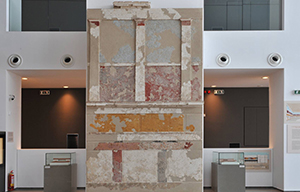Πέλλα
60 χρόνια αρχαιολογικού έργου (1957-2017)
Μαρία Λιλιμπάκη-Ακαμάτη
Δρ Αρχαιολογίας, Επίτιμη Διευθύντρια, Υπουργείο Πολιτισμού και Αθλητισμού
 Εξετάζοντας κανείς το αρχαιολογικό έργο της τελευταίας εξηκονταετίας στην Πέλλα (1957-2017), μπορεί να παρακολουθήσει την εξέλιξη της διαχείρισης του αρχαιολογικού αντικειμένου στον τόπο μας. Οι πρώτες συστηματικές ανασκαφές της περιόδου 1957-1963 και η αρχαιολογική δραστηριότητα από τα μέσα της δεκαετίας του ‘70 και εξής, έφεραν στο φως μεγάλο μέρος της «μεγίστης τῶν ἐν Μακεδονίᾳ πόλεων» (Ξενοφών, Ελληνικά V, 2, 13), η οποία, από τη δεκαετία του ‘90 και εξής άρχισε να αναδεικνύεται μέσα από σειρά σύνθετων ενεργειών, μελετών και επεμβάσεων στο πεδίο.
Εξετάζοντας κανείς το αρχαιολογικό έργο της τελευταίας εξηκονταετίας στην Πέλλα (1957-2017), μπορεί να παρακολουθήσει την εξέλιξη της διαχείρισης του αρχαιολογικού αντικειμένου στον τόπο μας. Οι πρώτες συστηματικές ανασκαφές της περιόδου 1957-1963 και η αρχαιολογική δραστηριότητα από τα μέσα της δεκαετίας του ‘70 και εξής, έφεραν στο φως μεγάλο μέρος της «μεγίστης τῶν ἐν Μακεδονίᾳ πόλεων» (Ξενοφών, Ελληνικά V, 2, 13), η οποία, από τη δεκαετία του ‘90 και εξής άρχισε να αναδεικνύεται μέσα από σειρά σύνθετων ενεργειών, μελετών και επεμβάσεων στο πεδίο.
Λέξεις ευρετηρίου: κατοικίες, ανάκτορο, Αγορά, ιερά, νεκροταφεία, τείχος, πολεοδομικό
COPYRIGHT: © Θέματα Αρχαιολογίας, 2017 - ISSN 2653-9292
Επικοινωνία με την συγγραφέα: makamati1@hotmail.com
Το πρωτότυπο άρθρο βρίσκεται στη βιβλιοθήκη του περιοδικού Θέματα Αρχαιολογίας
![]()
Αυτό το άρθρο χορηγείται με άδεια Creative Commons Αναφορά Δημιουργού-Μη Εμπορική Χρήση-Όχι Παράγωγα Έργα 4.0 Διεθνές .
Pella
60 years of archaeological work (1957-2017)
Maria Lilimpaki-Akamati
Ph.D. Archaeologist, Honorary Director of Antiquities, Ministry of Culture and Sports, Greece
 Ancient Pella, the capital of the Macedonian state for around 3 centuries, during the period of its greatest acme, stretches over an area of around 4.000 acres. The buildings are built within orthogonal town blocks of specific width and length already from the late 5th century BC, the period when Pella becomes the capital of the Macedonian kingdom. The city, which was still close to the sea at that time, near the shore of the Thermaic Gulf, succeeded an earlier settlement of the Bronze Age. The dense water-supply and sewage system, the public and private baths, and the houses testify the high living standard of the citizens, while the fortification, the palace, the agora, the public buildings, the sanctuaries, and the cemeteries contribute greatly to our knowledge on the city’s public and domestic life. Pella, still a prominent city after her conquest by the Romans (168 BC), is destroyed by an earthquake in the beginning of the 1st century BC; still, her south seaside part is still inhabited with the same town plan until the 4th century AD. The excavation work of 60 years at Pella led to the building of the new museum of Pella (2006-2009, CSF) and the restoration-enhancement of the archaeological site (2002-2015, CSF, NSRF).
Ancient Pella, the capital of the Macedonian state for around 3 centuries, during the period of its greatest acme, stretches over an area of around 4.000 acres. The buildings are built within orthogonal town blocks of specific width and length already from the late 5th century BC, the period when Pella becomes the capital of the Macedonian kingdom. The city, which was still close to the sea at that time, near the shore of the Thermaic Gulf, succeeded an earlier settlement of the Bronze Age. The dense water-supply and sewage system, the public and private baths, and the houses testify the high living standard of the citizens, while the fortification, the palace, the agora, the public buildings, the sanctuaries, and the cemeteries contribute greatly to our knowledge on the city’s public and domestic life. Pella, still a prominent city after her conquest by the Romans (168 BC), is destroyed by an earthquake in the beginning of the 1st century BC; still, her south seaside part is still inhabited with the same town plan until the 4th century AD. The excavation work of 60 years at Pella led to the building of the new museum of Pella (2006-2009, CSF) and the restoration-enhancement of the archaeological site (2002-2015, CSF, NSRF).
Key words: residences, palace, Agora, sanctuaries, cemeteries, wall, urban planning
COPYRIGHT: © Themes in Archaeology, 2017 - ISSN 2653-9292
Author for correspondence: makamati1@hotmail.com
The original article is in the Library of the Themes in Archeology
![]()
Creative Commons Attribution-NonCommercial-NoDerivatives 4.0 International .
Το πρωτότυπο άρθρο βρίσκεται στη βιβλιοθήκη του περιοδικού Θέματα Αρχαιολογίας
![]()
Αυτό το άρθρο χορηγείται με άδεια Creative Commons Αναφορά Δημιουργού-Μη Εμπορική Χρήση-Όχι Παράγωγα Έργα 4.0 Διεθνές .
